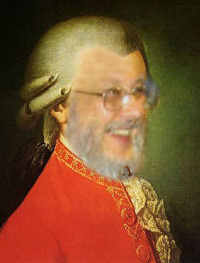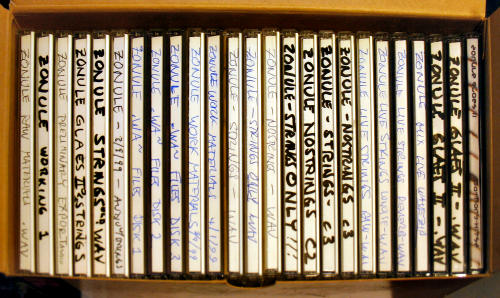A 365-Day Project
"We Are All Mozart"
A project to create
new works and change
the perception of the
music of our time.


 November 9, 2006
November 9, 2006 
Recently these commentaries talked about the struggle of archiving, and coincidentally the question of digital storage came up this morning on the Finale discussion list. The topic bears reconsidering because changes in technology have made it both easier and more difficult to preserve one's work.
The other reason to think about it again is a request that came in this afternoon. A performer in the U.K. wants to play Zonule Glaes II, which has not been heard since its premiere in Prague in 1999. The string quartet score is on line, as is a performance copy for listening. But what about the master playback recording that is reproduced along with a performance by the string quartet? Yes, there was a box of material on the shelf. Having just discussed the continued good condition of my archived CDs, I wondered... what would the condition of this recording be?
In 1999, my knowledge of the technology was less than today. The box contained my original sample materials and multitrack recording, several playback CDs of the final mix of the studio recording with string quartet, and the playback part alone ... and one CD with the master mix. Just one. Perhaps in 1999 it was forgivable to believe that recordable CDs would be a permanent storage medium, but not today. No, today my materials are archived on two CD-Rs and one DVD-R, with a copy kept on two spare hard drives, both removable in case of disaster.
Fortunately, the seven-year-old CD read into the computer without a pause. A copy was made and sent to Wales, and two more archive CDs were burned and put aside.
Technology development today gives little attention to preservation of anything more than accounting information. But to understand civilization, it's the culture that matters -- the cave paintings, the ziggurats, the vases and frescoes and plays and scores. The portraits and records and photographs and films, perhaps faded and cracked, but recoverable with fine tools and labor.
That was the archaeological and cultural circumstance until there arrived the digital age. To grasp the archiving dilemma, it is critical to understand that the representation of an image (say) as numbers is not merely a matter of counting something and writing it down, but rather of organizing the counting, encoding the counting, and storing the organized counting. Take colors. Are the colors numbered as primaries of paint or primaries of light? To match the red, green and blue of the television screen or the cyan, magenta, yellow and black of the printing press? A number represents a specific place or direction on an image, so how many places will be counted (resolution) and how detailed a number will be used to represent the color (depth)? Will information about brightness (luminance) be included? Will large redundant patches of color still be counted as individual points, or will they be collected en masse? And if they are collected together, at what point has a color changed enough to be considered for separate counting? In other words, how close is close enough to be 'the same'? Once those decisions are made, the data can be gathered. How often is it grouped together and digitally boxed up? What cross-checks are included to make sure errors don't creep into the numbers? It only takes a ver ysmal lerro ran dth edat amigh tsee munreadabl e,b utc anb erecovere db ycompensating for where the information got confused. Once it is boxed up, where will it be stored? Paper tape, punch cards, tapes, floppy disks, hard disks, CDs, DVDs, holograms? And once it is stored in some medium, how will it be recovered and decoded to replicate the numbers, and then reconstructed into an image?
There are two sides of the process, and a body of data. What's missing? The device that acts on the data -- the hardware, to be sure, but more than that the software, which is itself a set of data and computer programs that interact as a package with a larger software environment that accepts the programs' requests and translates them into a complex set of interactions with the hardware -- memory, disks, screens, keyboards.
In the early days of personal computing (before that term even existed), every action had to be hand-built from a set of binary numbers representing commands to the central processor and data with which that processor would act to create some sort of result. This was simple stuff, even menial. Want to read a keypress? Write a small routine to cyclically examine the state of the cross-matrix of keys on the keyboard. See row #3 and column #5 change state from one to zero, meaning someone pushed down a key that caused two fine wires to cross? According to a data table, the letter K must have been pressed. Retrieve that information. Find the routine to display the K on a screen, which would spit out a series of pulses perfectly synchronized with the electronic beam sweeping across the screen -- once it knew where the current point of focus for the letter was to be.
Oh yes, menial it was. Operating systems developed larger and sophisticated common libraries to handle these actions. But in building these libraries, companies also built in the fatal flaw: recreating the data of that photograph meant being able to turn on the devices, tell them to operate in a way that could read the data, discover the kind of data it was, and then know what to do with it.
Fatal flaw? Yes. The fatal flaw of digital information is that it is no longer some sort of comprehensible analog of the original which we might recover through brute force. No, the data is forever dependent on recovery methods being available. A friend has an old digital camera -- really old, among the first generation. In it are a few dozen photographs. But the interface is no longer made and if it were, there is no software to read it into a modern computer. He knows the photos exist, but he cannot recover them. What once granddad might recover with a few lenses and photo paper is now the realm of data recovery experts. The same for recordings -- there's no straight pin and paper cone for CDs.
The process of change has accelerated. Great swaths of digital knowledge are disappearing, swallowed up by incompatible hardware and software upgrades. I use Windows, which has been very good about making it possible for earlier data to be read from a quarter century ago. But in artistic time, a quarter century is just an intake of breath, not even time to exhale. The next iteration of Windows will obviate much of that old data and programming, and it will require keeping hardware maintained and old operating systems functioning -- the very problem that arose with analog equipment! Data is forever -- until upgrades make it useless and tethered software locks it away like the Codexului Rohonczi.
Sure, analog equipment needed maintenance. And old tapes had problems like the blubber-based slurries turning to muck over the years. Still, some careful dry-oven baking could recover these for transfer. As I said, with just a little information, most analog formats can be brute-force recovered.
Which brings me back to Zonule Glaes II. Although I have all the original materials and can recover that master recording, can I recover the mix? Let's see... there are .wav files. That's good; they're still fairly standard stuff. Oh, but they were saved with Wavezip compression, an obsolete format. Did I keep a copy? I'm not sure. And the master mix was done in some version of Cakewalk, probably version 6. And since then? Versions 7, 8 and 9, then Sonar 1, 2... up to version 5 is it? Will the current version read that master file? I don't know, but I do know that Cakewalk Pro Audio 9 does, and a copy of that exists on my Windows 98SE computer. And this is all stuff that I know and will vanish when I forget it or get hit by a passing hay truck. Even the score on line is a PDF, a pretty good cross-platform data format -- for now. At what point will the web page's markup become obsolete? The PDF rules change irrevocably? The score, unless rendered on paper, vanish into digital oblivion?
This is not a point about the need to archive, only the practical issues that have come with the shift to digital information-keeping. Fortunately for this one composition, the files are all still readable and intact and if a remix is needed, it can be accomplished. But In Bocca al Lupo? Yes indeed, I have notebooks full of printouts and the computers that could run that sound installation are neatly packed away. Unfortunately, the fate of digital information is affected in unanticipated ways. Those old computers had custom operating system that I wrote and stored in EPROM (erasable, programmable read-only memory). EPROMs are sort of like the flash cards or memory sticks in today's cameras, except that once programmed, the information was supposed to stay permanently emblazoned until the top window was exposed to strong ultraviolet light for a prolonged period. Of course, no one could do real-time aging tests. And so the entire operating system on these EPROMS, tenderly stored in total darkness, has erased itself over twenty years. In Bocca al Lupo is gone to me, gone to the odd future musicologist who might think it interesting.
Digital data is friable. Get ready for a curious Dark Ages of cultural history.

The Zonule Glaes II archive from 1999 spanning 24 CD-Rs, with one copy of the final audio CD (far right).